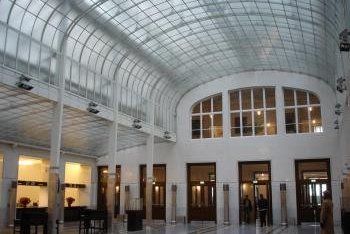
Why another review about Vienna? Vienna is one of the WHS with the most visitors and most reviews on this website. The answer is: just to draw attention to a building, that is often overlooked by tourists who spend only a few days in Vienna. Of course, the city is mainly known for the Hofburg, the Opera House, the buildings on the Ringstrasse, and Schönbrunn. But there are also extraordinary buildings of Art Nouveau. Well known are the Vienna Secession and the Karlsplatz Stadtbahn Station, mainly because they are located at tourist hotspots. The building, which I like in Vienna at most (if one can ever decide) is the Postsparkasse (Austrian Postal Savings Bank) built by Otto Wagner. The building covers an entire city block, and it is Wagner's most modern work. A characteristic feature is the façade with aluminium-covered iron bolts, which are reminiscent of a treasure chest. Wagner not only constructed the building, but also designed the complete interior: furniture, lamps, clocks, floor coverings, safes, etc. For example, a glazed prism floor was installed in the Banking Hall to light the rooms below., Both the façade and the interior perfectly illustrate his motto: What is impractical can never be beautiful. It is still used as a bank building, you can visit the Main Banking Hall from Monday to Saturday. There is also a small museum with a second, small Banking Hall.
There are some more Wagner buildings outside the WHS core zone that are worth a visit: two …
Keep reading 0 commentsAnonymous
Funerary and memory sites of the First World War
Funerary and memory sites of the First World War (Inscribed)

Im a 32 year old belgian, this review starts with a shame on me. Why? Well today i visited the Westhoek for the first time.
It was a beautiful sunny early autumn day so we wanted to visit the theme park Bellewaerde near Ypres. At arrival we saw that it was overcrowded so we decided to explore the region instead. Our tour brought us from one cemetery to the other. all as confronting as breathtaking. the amazing serenity, the perfect maintenance, the purity of every memorial, the multitude of origins of victims made us realize the global size of horror, trauma, tragedy millions of people from all around the world carried and are still carrying today. After visiting the trenches of Hill 61 and the small but very straight to the bone museum next to it, our feet were finally put in the middle of the reality of the Westhoek inhuman cruelty of 1914 till1918. This Iddillic scenery should not lose its historical importance and contrast.
You see here that people write long reviews. I don't think its because we like to write. I think its just because 'we have to' after visiting this most beautiful region with such a short but oh so important black chapter in history.
I love to travel and with great admiration I have visited many World Heritage Sites already in my life. But I live only 1h from the Westhoek, ignorant and naive. A Theme park with some rollercoasters with too long cues should …
Keep reading 0 comments
On a day trip from Vienna I went to both Krems, Weißenkirchen and Dürnstein. Both proved to be quite a pleasant surprise.
Krems is the central town of the Wachau and has a nice historic town with a monastery to be visited. Some modern museums are nearby, notably a very good caricature museum. From Krems you can take the Wachau Train which goes along the left Danube bank through the Wachau villages. Weißenkirchen is the first stop. It is the village displaying the oldest architecture. It is very picturesque with its enormous medieval fortified church in the middle of the village. Dürnstein (the next stop of the train) is probably the prettiest of the three and is overloaded with tourists on weekends. It is beautifully located along one of the Danube's curves, amongst vineyards and near the ruins of Dürnstein Castle. Its most spectacular views are from the local Jesuit monastery that can and should be visited exactly for this reason.
The Wachau is very compact and easily accessibly with public transport from Vienna. Note that there are no bridges so if you want to visit famous Stift Melk you have to take a different train from Vienna or go all the way to Sankt Pölkten. Famous local products are wines and apricot jam.
Keep reading 0 comments
It is surprising that the site remains without signage. I wish I could put some interpretative sign boards there. I remember every bit of the area even after 40 years of my long association with the fossils and rocks of the region.I am in the possession of fossil bearing original rocks and casts of fossis. My Masters thesis submitted to Memorial University details the terrain how it was like in 1967-69.
Keep reading 0 commentsAssif
Wooden Churches of the Slovak Carpathians
Wooden Churches of the Slovak Carpathians (Inscribed)

During my trip to the Tatra Mountains I have been to the historic town of Kezmarok (Käsmark) not far away from Levoca, which is another WHS. Kezmarok used to be another Carpathian Saxon town with typical German architecture. The town is very nice and can easily serve as a base for day trips to the Tatra Mountains. The WHS part of town is its wooden Protestant church, originally built outside the city walls.
As the Austro-Hungarian rule was Catholic Protestantism was discouraged. As a result the local Protestant church had to be built outside. It was forbidden to use stone in its construction and its height was limited. The local Germans overcame these difficulties with quite an amazing construction. From the outside the church looks rather plain and this is in fact the only photo available online, but once getting inside the building, the elaborate Baroque decoration strikes you. It's design for itself is not that extraordinary but the fact it's all made of wood, straw and metal.
The church still serves the local German minority. It was also very interesting to talk German with them and listen to their stories about growing up in Communist Czechoslovakia and having to cope with strong anti German emotions. Funny how luck changes...
Keep reading 0 comments
The Tatra Mountains are probably Slovakia's best known attraction. They are part of the Carpathian range which is currently divided between Slovakia, Poland, Ukraine, Romania as well as little chunks in Hungary and the Czech Republic. Among these countries Slovakia features the highest peaks. This said, I have been to the Carpathians in both Slovakia and the Ukraine and I find them much less impressive than the Alpine landscapes I viewed in Switzerland (which probably similar to Austria, Germany, France, Slovenia and Italy). I read the natural component is very similar in the Carpathians and the Alps (although the latter are higher). The main difference, however, lies in the human component. I found the Slovak development of the Tatra area rather tasteless. Apart from many ugly buildings there were barely any unspoiled forests we drove by. Of course I am not fully aware of the exact boundaries of the suggested nomination. The core zone may lie higher or in more isolated areas. However, I think nearby Austria keeps its forests better.
Keep reading 0 comments
Before heading to Vlkolinec I read some reviews here and elsewhere and had the impression I was going to be disappointed by something underwhelming. Well, the village is extremely small but I found it full of atmosphere. The mountainous location is lovely as the wooden houses. There isn't much to do there for more than an hour but still I found the visit most rewarding. Compared to another famous vernacular Slovak site - Cicmany, I actually found Vlkolinec more impressive, although Cicmany too is certainly worthwhile.
Keep reading 0 comments
Unfortunately I don't see any reasons why this should be a World Heritage site. Amalienborg is a beautiful palace and the district around it is full of nice buildings but I didn't see anything special that would make it worth of World Heritage status. It lacks the "outstanding universal value". Also Unesco website's description doesn't give any good reasons to add it. Europe is full of places just like Amalienborg.
But Copenhagen as a whole is an amazing city! I'd like to see a nomination containing more historical places in Copenhagen, something like "Historical City of Copenhagen"!
Keep reading 0 comments
We visited Saint-Emillion on a day trip from Bordeaux. Trains leave only about 5 times a day, and we found that the 10.40 departure suited us best. The train takes just over half an hour. From the tiny railway station in Saint-Emillion a walk of about 20 minutes is required to get to the city center. This walk actually provided us with our first photo opportunities of the famous vineyards, so it was no hassle at all.
The town of Saint-Emilion likes its tourist Euro, so almost every building in the old city center is converted into a shop, a wine bar, or a restaurant. Most visitors seem to come there on bus tours or by their own car. The medieval streets are bustling with people, and as we were blessed by extremely sunny and warm weather for this time of year the terraces were crowded. We enjoyed a great meal of mussels and french fries there – such pleasures is what a mini-break is all about.
The two major monuments of Saint-Emilion are its churches: the weird Monolithic Church and the exuberant Collegiate Church. The latter has lots of colourful stained glass windows, through which the sunlight shines to illuminate the interior.
We visited the surrounding vineyard landscape by the little tourist train that loops through it. The fields were pretty dry already, so I was not as impressed by the scenery as I was 8 weeks ago when I visited the Lavaux vineyard terraces in …
Keep reading 0 comments
There's no doubt that Bordeaux is a very pleasant and liveable city. We arrived late in the evening (11 p.m.) and our taxi driver proudly pointed out all the monumental highlights: the bridge across the Garonne, the Place de la Bourse, the old city gates and the water mirror to name but a few. They are all flooded in light after it gets dark: a very fine sight.
The next morning we did a self-guided tour of the main city area, which is not very large. The streets are well-geared to pedestrians, and everything looks very neat and well-preserved. The buildings are very uniform in style and colour. We were already completely in awe of the monumental fountain with its statues of horses at the Place de Quinconces.
As other reviewers have remarked, there are no really outstanding buildings that warrant a separate visit. The most interesting structure may be the Cathedral. This is part of the French Routes to Santiago de Compostela also, and I think that it fits that label better because of its age.
There are lots of smaller things to see and do however in the streets of Bordeaux: the pastry shops, the plentiful terraces of its bars and restaurants, the well-stocked shops (I bought some smelly cheese to take home with me!), the Jardin Public. Combined with especially sunny and warm weather for early October, we had a good time in Bordeaux.
Keep reading 0 comments
I visited Altamira in the late 60's and for the price of the equivalent of $3US hired an official guide for a day who took me through all the locations open to tourists which were stunning beyond ones imagination and a very spiritual experience.
We then proceeded to go deeper into the complex with our own flashlights and crawled through fissures and saw petroglyphs and finger drawings in the mud floor.
I have seem many cave drawings in South Africa and France but the Hall of Paintings is only second to Lascaux,
A truely marvellous experience
Keep reading 0 comments
The Thracian Tomb in Kazanluk, can be one of the most frustrating WHS sites to visit due to the Bulgarian government really trying to preserve the tomb. We arrived first thing in the morning on a rainy, misty day which is perfect when visiting cemetaries or tombs, and we immediately paid our fee. We looked around the museum, and then walked into the tomb's replica which is a very small area, so it did not take long. I was very dissappointed, and had heard that sometimes the officials will let you in the real tomb. I asked, they made me pay another fee (20 leva) and then they made us cover our clothes with a lab coat, and our feet with booties to go into the real thing. Not surprisingly, the "fake" was indeed an exact replica and it did look exactly like the original. I don't think this is the most impressive WHS site in Bulgaria, but the story of the tomb is interesting and the frescoes are gorgeous. To read more about our visit, please visit our website at: http://rovingvails.com/blog/2010/06/26/760/ .
Keep reading 0 comments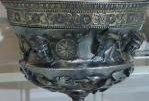
The Dutch T-List nomination for an extension of the Frontiers of the Roman Empire has come as a surprise to me:
a. The Advisory Committee had concluded in 2010 that there was no coordination between the provinces and cities along the former Roman frontier line in the Netherlands on this subject. So there was insufficient steering and power behind a possible nomination.
b. There is nothing left to see!
The Romans arrived around 15 B.C. in what is now The Netherlands, and stayed intermittently for some 300 years. They constructed a number of fortifications along the Rhine river. Roman objects have been found in the moist ground along the river, and sometimes they even have been fished from the water.
The Roman remains in the Netherlands have the obscurity of the Pile Dwellings in the Alps or the Struve Geodetic Arc. Except for a single stone or two, there's nothing to warrant a visit. Museum Het Valkhof in Nijmegen probably is the best option to get a feel of what impact the Romans had on the Netherlands. In October 2011 I spent about an hour there, enjoying the sometimes surprisingly precious objects. The photo attached for example is a decorated silver Roman beaker.
Keep reading 0 comments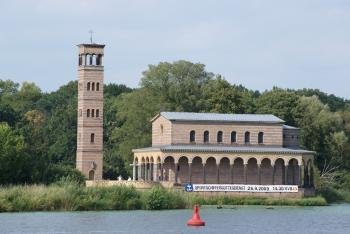
The Parks of Potsdam and Berlin extend over a large area and it is hardly possible to visit all sites at one day. There are six major parks: Sanssouci, New Garden, Babelsberg, Glienicke, Pfaueninsel and Sacrow. In each of the parks there are numerous palaces and small structures, built between the mid 18th and early 20th Century. Certainly, the main sight is the Park Sanssouci. In 1745, King Frederick II commissioned his architect Von Knobelsdorff to build a summer palace in the rococo style, in Potsdam, just outside Berlin. Sanssouci should be the intellectual centre of his empire and his refuge from the military and austere capital of Berlin. Frederick II was not only a statesman and military leader, he was also interested in art, science and philosophy. Voltaire spent two years as a guest in Sanssouci, and here was also the meeting of Frederick II with Johann Sebastian Bach. The composition "The Musical Offering" based upon a theme by Frederick II. His descendants built new parks and palaces around the lakes in Potsdam.
We visited Potsdam in the summer of 2009 and spent two and a half days there. The first day we went to the Park Sanssouci. The view of the palace with the wine terraces and the fountain is magnificent. It is always very crowded, but we were early enough to avoid the queues at the entrance. The audio guide tour through the interior took about 45 minutes. It was interesting to see the historic rooms, …
Keep reading 0 comments
Simien mountains are stunningly beautiful, no doubt about it. We have spent 4 days there, hiked up to Chenek, gone through all kinds of weather... amazing experience, when it comes to nature.
Only one thing was frustrating, quite a few local people got used to do harsh bussines here - thus Debark as a whole is quite annoying, transport to Sankaber (30km) is ridiculously expensive, too many people try to cheat here...
I had the chance to compare with Bale Mountains and it was totally different approach to a visitor. The Simien HQ should do something about it, otherwise it might be late soon - despite the beauty of the mountains.
Keep reading 0 comments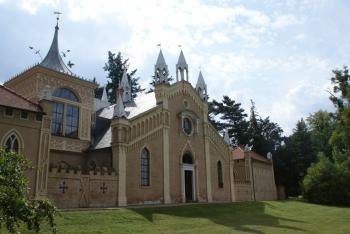
The Garden Kingdom of Dessau-Wörlitz covers an area of about 140 square kilometers and consists of several English landscape gardens. The largest and most beautiful park is in Wörlitz. We were in Dessau in the summer of 2009, and after we had visited the Bauhaus sites the day before, the Garden Kingdom was the next WHS on our list. It was a warm summer day, so we went by bicycle to the Wörlitz Park (about 20 km). Thereby, we came also through some of the other parks: Georgium and Luisium with smaller palaces and pavilions, and the Sieglitz woodland park. In Worlitz we visited the Palace, the Gothic House (photo) and the Villa Hamilton. All the parks are well maintained and preserved and we enjoyed our bike tour. However, I found the Garden Kingdom not outstanding. The parks in Berlin and Potsdam, which we had visited some days earlier, impressed me much more. But maybe I was biased because we had visited too many parks in just a few days and because in Dessau I was more focused on the Bauhaus sites.
Keep reading 0 comments
Hello. I'm from Canada and I visited Cologne Cathedral twice, once in 1989 and again during the World Youth Day event in August 2005. The cathedral is impressive both on the outside and inside. Architecturally, it is a classic, complete Gothic cathedral through and through. Yes, the exterior looks dirty, but the dark grit is mostly likely due to the carpet bombing of the city during the Second World War (which explains why the rest of the city looks fairly modern). I was surprised to learn in university that the cathedral was struck by bombs several times by the allies. Fortunately, the Germans removed and safely stored the stained glass windows in anticipation of damage, until after the war. And thankfully, the cathedral was not severely damaged. So I imagine that one day, the exterior will be cleaned up - an enormous undertaking. My greatest joy is looking at beautiful stained glass windows. They are outstanding. I did not see the new window that was installed later in 2007 - it's contemporary, but fairly uninspiring and does not fit in with the rest of the windows. I think there must have been an artist
Keep reading 0 comments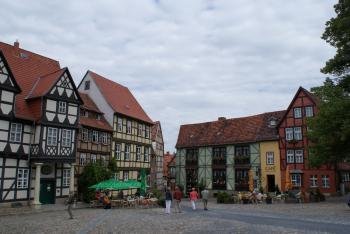
Quedlinburg is a small medieval town with the largest number of half-timbered houses in Germany. There are more than one thousand from six centuries. The town has a nice market square with the town hall and the Roland statue, the WHS includes also the Castle Hill with the Collegiate Church St Servatius, and several other churches. The Romanesque church of St Wiperti with its cemetery reminded me of one of these small enchanting churches in England. The charm of the town is more the preserved medieval townscape and not the extraordinary value of individual buildings. However, I liked Quedlinburg less than other medieval towns in Germany, such as the nearby Goslar or Bamberg. But I can not explain exactly why. My highlights in Quedlinburg are barely related with the WHS: the Lyonel Feininger Gallery and the Café Vincent, where you can taste about 30(!) different homemade cheesecakes.
Keep reading 0 comments
I spent a few days in Tallinn some 8-9 years ago.I loved its old architecture,winding streets,shops,the open air vendors (and their merchandise) on the square (forget its name)and beer.Estonians being in the same ethnic group as us Finns ,swelled my Finno Ugric heart to the bursting point.We both are small nations and have been under many conquerors and now finally our dream of independence has come true.
Keep reading 0 comments
The older part of the city was spared major destruction during WW two, but over 50 years of neglect under Soviet Rule is still evident. Churches become warehouses, museums and dining halls. The three month tourist season provides the major income for residents. There were speciality shops selling woollen products, amber and linens. Under the Soviets about 20 per cent of the population was deported to Siberia including teachers and almost anybody with an education. Estonia is a small country of about 1,500,000 people.
Keep reading 0 comments